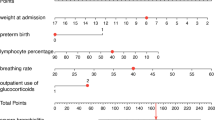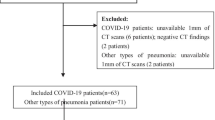Abstract
Objectives
The Omicron variant of severe acute respiratory syndrome coronavirus 2 (SARS-CoV-2) is highly contagious, fast-spreading, and insidious. Most patients present with normal findings on lung computed tomography (CT). The current study aimed to develop and validate a tracheal CT radiomics model to predict Omicron variant infection.
Materials and methods
In this retrospective study, a radiomics model was developed based on a training set consisting of 157 patients with an Omicron variant infection and 239 healthy controls between 1 January and 30 April 2022. A set of morphological expansions, with dilations of 1, 3, 5, 7, and 9 voxels, was applied to the trachea, and radiomic features were extracted from different dilation voxels of the trachea. Logistic regression (LR), support vector machines (SVM), and random forests (RF) were developed and evaluated; the models were validated on 67 patients with the Omicron variant and on 103 healthy controls between 1 May and 30 July 2022.
Results
Logistic regression with 12 radiomic features extracted from the tracheal wall with dilation of 5 voxels achieved the highest classification performance compared with the other models. The LR model achieved an area under the curve of 0.993 (95% confidence interval [CI]: 0.987–0.998) in the training set and 0.989 (95% CI: 0.979–0.999) in the validation set. Sensitivity, specificity, and accuracy of the model for the training set were 0.994, 0.946, and 0.965, respectively, whereas those for the validation set were 0.970, 0.952, and 0.959, respectively.
Conclusion
The tracheal CT radiomics model reliably identified the Omicron variant of SARS-CoV‑2, and may help in clinical decision-making in future, especially in cases of normal lung CT findings.
Zusammenfassung
Ziel
Die Omikronvariante von SARS-CoV‑2 („severe acute respiratory syndrome coronavirus 2“) ist hoch ansteckend, verbreitet sich schnell und ist tückisch. Die meisten Patienten weisen einen Normalbefund in der Computertomographie (CT) der Lunge auf. Ziel der vorliegenden Studie war es, ein CT-Radiomics-Modell der Trachea zu entwickeln und zu validieren, anhand dessen sich eine Infektion mit der Omikronvariante vorhersagen lässt.
Material und Methoden
In dieser retrospektiven Studie wurde zwischen 1. Januar und 30. April 2022 auf der Grundlage eines Trainingsdatensatzes von 157 Patienten mit einer Infektion durch die Omikronvariante und 239 gesunden Kontrollpersonen ein Radiomics-Modell erzeugt. Ein Satz morphologischer Expansionen mit Dilatationen von 1, 3, 5, 7 und 9 Voxeln wurde auf die Trachea angewandt, und radiomische Charakteristika wurden aus verschiedenen Dilatationsvoxeln der Trachea extrahiert. Die logistische Regression (LR), die Support-Vector-Machines(SVM)- und die Random-Forests(RF)-Methode wurden angewandt und bewertet; die Modelle wurden an 67 Patienten mit der Omikronvariante und 103 gesunden Kontrollen zwischen 1. Mai und 30. Juli 2022 validiert.
Ergebnisse
Die LR mit 12 radiomischen, aus der Trachealwand mit Dilatation von 5 Voxeln extrahierten Merkmalen erzielte die höchste Klassifikationsleistung im Vergleich zu anderen Modellen. Mit dem LR-Modell wurde eine Fläche unter der Kurve („area under the curve“ [AUC]) von 0,993 (95%-Konfidenzintervall [95%-KI]: 0,987–0,998) im Trainingsdatensatz und 0,989 (95%-KI: 0,979–0,999) im Validierungsdatensatz erzielt. Sensitivität, Spezifität und Genauigkeit des Modells für den Trainingsdatensatz betrugen 0,994; 0,946 bzw. 0,965, während die Werte für den Validierungsdatensatz bei 0,970; 0,952 bzw. 0,959 lagen.
Schlussfolgerung
Mit dem CT-Radiomics-Modell wurde die Omikronvariante von SARS-CoV‑2 zuverlässig erkannt, es kann möglicherweise in Zukunft zur klinischen Entscheidungsfindung beitragen, insbesondere in Fällen mit einem normalen Befund in der Lungen-CT.





Similar content being viewed by others
Data availability statement
The data are not publicly available to protect the individuals’ privacy. The data that support the findings of this study are available from the corresponding author, Yun Bian, upon reasonable request.
References
Zhu N, Zhang D, Wang W et al (2020) A novel coronavirus from patients with pneumonia in China, 2019. N Engl J Med 382(8):727–733. https://doi.org/10.1056/NEJMoa2001017
Pulliam JRC, van Schalkwyk C, Govender N et al (2022) Increased risk of SARS-CoV‑2 reinfection associated with emergence of Omicron in South Africa. Science 376(6593):eabn4947. https://doi.org/10.1126/science.abn4947
Ulloa AC, Buchan SA, Daneman N et al (2022) Estimates of SARS-CoV‑2 omicron variant severity in Ontario, Canada. JAMA 327(13):1286–1288. https://doi.org/10.1001/jama.2022.2274
Wolter N, Jassat W, Walaza S et al (2022) Early assessment of the clinical severity of the SARS-CoV‑2 omicron variant in South Africa: a data linkage study. Lancet 399(10323):437–446. https://doi.org/10.1016/S0140-6736(22)00017-4
Jassat W, Abdool Karim SS, Mudara C et al (2022) Clinical severity of COVID-19 in patients admitted to hospital during the omicron wave in South Africa: a retrospective observational study. Lancet Glob Health 10(7):e961–e969. https://doi.org/10.1016/S2214-109X(22)00114-0
Rubin GD, Ryerson CJ, Haramati LB et al (2020) The role of chest imaging in patient management during the COVID-19 pandemic: a multinational consensus statement from the fleischner society. Radiology 296(1):172–180. https://doi.org/10.1148/radiol.2020201365
Yang N, Wang C, Huang J et al (2022) Clinical and pulmonary CT characteristics of patients infected with the SARS-CoV‑2 omicron variant compared with those of patients infected with the Alpha viral strain. Front Public Health 10:931480. https://doi.org/10.3389/fpubh.2022.931480
Fang X, Li X, Bian Y et al (2020) Radiomics nomogram for the prediction of 2019 novel coronavirus pneumonia caused by SARS-CoV‑2. Eur Radiol 30(12):6888–6901. https://doi.org/10.1007/s00330-020-07032-z
Liu H, Ren H, Wu Z et al (2021) CT radiomics facilitates more accurate diagnosis of COVID-19 pneumonia: compared with CO-RADS. J Transl Med 19(1):29. https://doi.org/10.1186/s12967-020-02692-3
Chen HJ, Mao L, Chen Y et al (2021) Machine learning-based CT radiomics model distinguishes COVID-19 from non-COVID-19 pneumonia. BMC Infect Dis 21(1):931. https://doi.org/10.1186/s12879-021-06614-6
Chen H, Zeng M, Wang X et al (2021) A CT-based radiomics nomogram for predicting prognosis of coronavirus disease 2019 (COVID-19) radiomics nomogram predicting COVID-19. Br J Radiol 94(1117):20200634. https://doi.org/10.1259/bjr.20200634
Shi H, Xu Z, Cheng G et al (2022) CT-based radiomic nomogram for predicting the severity of patients with COVID-19. Eur J Med Res 27(1):13. https://doi.org/10.1186/s40001-022-00634-x
Yuan G, Wang H, Zhao Y et al (2022) Early identification and severity prediction of acute respiratory infection (ESAR): a study protocol for a randomized controlled trial. BMC Infect Dis 22(1):632. https://doi.org/10.1186/s12879-022-07552-7
Moons KG, Altman DG, Reitsma JB et al (2015) Transparent reporting of a multivariable prediction model for individual prognosis or diagnosis (TRIPOD): explanation and elaboration. Ann Intern Med 162(1):W1–73. https://doi.org/10.7326/M14-0698
Simpson S, Kay FU, Abbara S et al (2020) Radiological society of North America expert consensus document on reporting chest CT findings related to COVID-19: endorsed by the society of thoracic radiology, the American College of Radiology, and RSNA. Radiol Cardiothorac Imaging 2(2):e200152. https://doi.org/10.1148/ryct.2020200152
Yoon SH, Lee JH, Kim BN (2022) Chest CT findings in hospitalized patients with SARS-CoV-2: delta versus omicron variants. Radiology. https://doi.org/10.1148/radiol.220676
van Griethuysen JJM, Fedorov A, Parmar C et al (2017) Computational radiomics system to decode the radiographic phenotype. Cancer Res 77(21):e104–e107. https://doi.org/10.1158/0008-5472.CAN-17-0339
Shi F, Chen B, Cao Q et al (2022) Semi-supervised deep transfer learning for benign-malignant diagnosis of pulmonary nodules in chest CT images. IEEE Trans Med Imaging 41(4):771–781. https://doi.org/10.1109/TMI.2021.3123572
General office of national health committee. Office of state administration of traditional Chinese medicine. Notice on the issuance of a program for the diagnosis and treatment of novel coronavirus infected pneumonia (trial ninth edition). http://www.nhc.gov.cn/yzygj/s7653p/202203/b74ade1ba4494583805a3d2e40093d88.shtml
Li L, Wang L, Zeng F et al (2021) Development and multicenter validation of a CT-based radiomics signature for predicting severe COVID-19 pneumonia. Eur Radiol 31(10):7901–7912. https://doi.org/10.1007/s00330-021-07727-x
Lin L, Liu J, Deng Q et al (2021) Radiomics is effective for distinguishing coronavirus disease 2019 pneumonia from influenza virus pneumonia. Front Public Health 9:663965. https://doi.org/10.3389/fpubh.2021.663965
Nagaraj Y, de Jonge G, Andreychenko A et al (2022) Facilitating standardized COVID-19 suspicion prediction based on computed tomography radiomics in a multi-demographic setting. Eur Radiol 32(9):6384–6396. https://doi.org/10.1007/s00330-022-08730-6
Zhang L, Jiang B, Wisselink HJ et al (2022) COPD identification and grading based on deep learning of lung parenchyma and bronchial wall in chest CT images. Br J Radiol 95(1133):20210637. https://doi.org/10.1259/bjr.20210637
Venerito V, Manfredi A, Lopalco G et al (2022) Radiomics to predict the mortality of patients with rheumatoid arthritis-associated interstitial lung disease: a proof-of-concept study. Front Med 9:1069486. https://doi.org/10.3389/fmed.2022.1069486
Tsakok MT, Watson RA, Saujani SJ et al (2022) Chest CT and hospital outcomes in patients with omicron compared with delta variant SARS-CoV‑2 infection. Radiology. https://doi.org/10.1148/radiol.220533
Hui KPY, Ho JCW, Cheung MC et al (2022) SARS-CoV‑2 Omicron variant replication in human bronchus and lung ex vivo. Nature 603(7902):715–720. https://doi.org/10.1038/s41586-022-04479-6
Sun R, Limkin EJ, Vakalopoulou M et al (2018) A radiomics approach to assess tumour-infiltrating CD8 cells and response to anti-PD‑1 or anti-PD-L1 immunotherapy: an imaging biomarker, retrospective multicohort study. Lancet Oncol 19(9):1180–1191. https://doi.org/10.1016/S1470-2045(18)30413-3
Beigelman-Aubry C, Brillet Grenier PYPA (2009) MDCT of the airways: technique and normal results. Radiol Clin North Am 47(2):185–201. https://doi.org/10.1016/j.rcl.2009.01.001
Funding
This work was supported in part by the National Science Foundation for Scientists of China (81871352, 82171915, 82171930, and 82271972), The Natural Science Foundation of Shanghai Science and Technology Innovation Action Plan (21ZR1478500, 21Y11910300), Clinical Research Plan of SHDC (SHDC2020CR4073, SHDC2022CRD028), and 234 Platform Discipline Consolidation Foundation Project (2020YPT001).
Author information
Authors and Affiliations
Contributions
Xu Fang, Fang Liu, and Jing Li collected and analyzed the clinical data. Feng Shi, Ying Wei, and Jiaojiao Wu analyzed the radiomics data. Xu Fang wrote the paper. Feng Shi and Ying Wei reviewed and edited paper. Jianping Lu, Chengwei Shao, and Yun Bian were involved in investigation and funding acquisition and supervision. Chengwei Shao and Yun Bian revised this paper. All authors read and approved the final manuscript.
Corresponding authors
Ethics declarations
Conflict of interest
X. Fang, F. Shi, F. Liu, Y. Wei, J. Li, J. Wu, T. Wang, J. Lu, C. Sha and Y. Bian declare that they have no competing interests.
For this article no studies with human participants or animals were performed by any of the authors. All studies mentioned were in accordance with the ethical standards indicated in each case. The retrospective cross-sectional study was reviewed and approved by the Biomedical Research Ethics Committee of Changhai Hospital. The requirement for patient consent was waived.
The supplement containing this article is not sponsored by industry.
Additional information
Publisher’s Note
Springer Nature remains neutral with regard to jurisdictional claims in published maps and institutional affiliations.
The authors Xu Fang and Feng Shi contributed equally to the manuscript.

Scan QR code & read article online
Rights and permissions
About this article
Cite this article
Fang, X., Shi, F., Liu, F. et al. Tracheal computed tomography radiomics model for prediction of the Omicron variant of severe acute respiratory syndrome coronavirus 2. Radiologie (2024). https://doi.org/10.1007/s00117-024-01275-3
Received:
Accepted:
Published:
DOI: https://doi.org/10.1007/s00117-024-01275-3




